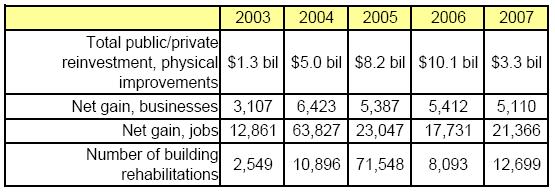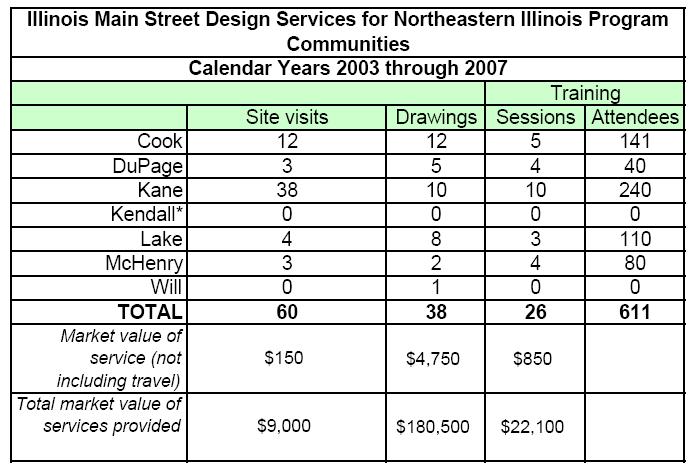When visiting any city, large or small, one can visually determine, at least on a surface level, the relative health of its downtown or neighborhood business districts. Are there businesses on the street? Are people walking in and out of storefronts? Are they buying anything? How many vacant storefronts or lots are there? Does it seem like a livable place? Would you take your family?
Historic preservation can be a tool for spurring economic development in downtowns and in neighborhoods. Downtown revitalization is about creating jobs, recruiting new businesses, helping existing businesses to stay and grow, increasing a municipality's tax base, increasing the value of buildings, and increasing overall financial activity in that area (Rypkema, 2003). One of the vital parts to the revitalization of downtown Chicago was an acknowledgement of the unique spaces in and around downtown. Though the city's historic preservation ethic has been debated and analyzed for decades and continues to be so, the city did understand that, by celebrating the rich heritage of such assets as State Street, the elevated Loop tracks, and historic architecture (such as the Reliance Building – now the Hotel Burnham), it was promoting an experience that tourists can only have in downtown Chicago. This thought process has carried over to places like the Prairie Avenue Historic District, which is an historic asset that is important to the beginnings of the city, has been successfully leveraged in the revitalization of the South Loop neighborhood around it.
Successful neighborhood commercial district revitalization, when paired with a progressive preservation ethic, creates strong pockets of economic development because they 1) create jobs, ideally for neighborhood residents; 2) reduce overall transportation costs; 3) increases the overall tax bases; 4) create opportunities for small businesses and expanded "work-at-home" businesses; 5) create business profits, and; 6) create opportunities specifically for minority and immigrant entrepreneurship (Rypkema 2003).
In 1977, the Chicago office of the National Trust for Historic Preservation (NTHP), in response to the growing decline of traditional historic downtowns, launched a pilot program consisting of three communities (one in Illinois). The purpose of the program was to determine if historic downtowns could become economically viable and simultaneously celebrate its architectural and cultural history. The success of the pilot program gave rise in 1980 both to the National Trust Main Street Center and to a new historic preservation-based economic development strategy, the Main Street "Four-Point Approach." Main Street is a community-driven, volunteer-based comprehensive revitalization strategy that uses historic preservation and rehabilitation as an economic development tool. More than thirty years since the pilot program, the Main Street Four-Point Approach can be found in over 2,200 communities, from small to mid-sized downtowns, to urban neighborhood business districts (National Trust for Historic Preservation, 2008). Main Street's comprehensiveness comes from its four basic tenets: organization of the revitalization effort using volunteers and public-private partnerships, promotion of the entire business district as a unique place to shop, play, work, invest, and live, a focus on aspects of design that make the business district aesthetically pleasing, and economic restructuring of the local economy, which involves knowing the district's market and creating opportunities for new development and job creation (National Trust for Historic Preservation, 2008).
Main Street is a proven economic development strategy. For a program that focuses on commercial corridors and small businesses, it packs respectable economic punch. Working from reinvestment statistics tracked by the National Trust Main Street Center and reported by the Center as cumulative statistics, here is a brief look at the economic impact that Main Street programs have made in communities nationwide over a five-year period:
ECONOMIC STATISTICS, NATIONAL TRUST MAIN STREET CENTER, 2003-2007

Sources: National Trust Main Street Center; CMAP calculations
Illinois Main Street began to implement this revitalization strategy throughout the state in 1993; shortly thereafter, Illinois Main Street was brought to northeastern Illinois. Illinois Main Street is part of the Office of the Lieutenant Governor and is in partnership with the Illinois Historic Preservation Agency (IHPA). Statewide, Illinois Main Street services 68 municipalities and neighborhoods; currently almost a quarter of Illinois Main Street programs are in northeastern Illinois. (National Trust for Historic Preservation, 2008) Through the work of Illinois Main Street, communities in northeastern Illinois have achieved tremendous success in revitalizing their business districts.
One of the benefits of being a part of the Illinois Main Street program is having access to top-notch preservation architects at IHPA. From training committee volunteers on the design aspect of the Main Street Four-Point Approach to design renderings for buildings, IHPA has been a steady partner and a great asset to communities statewide, especially for Illinois Main Street communities. Here is a look at IHPA's work in Illinois Main Street communities in northeastern Illinois from July 2006 to June 2008. It not only speaks to IHPA's commitment to Illinois Main Street, but also especially to the commitment of hundreds of volunteers who decided to take an active part in revitalizing their communities, building by building, business by business.

*There are no Illinois Main Street programs in Kendall County.
Source: Illinois Historic Preservation Agency, 2008